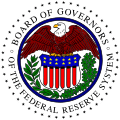William P. G. Harding
| William Harding | |
|---|---|
 | |
| 2nd Chair of the Federal Reserve | |
|
In office August 10, 1916 – August 9, 1922 | |
| President |
Woodrow Wilson Warren Harding |
| Deputy |
Paul Warburg Albert Strauss Edmund Platt |
| Preceded by | Charles Hamlin |
| Succeeded by | Daniel Crissinger |
| Personal details | |
| Born |
May 5, 1864 Boligee, Alabama, U.S. |
| Died |
April 7, 1930 (aged 65) Boston, Massachusetts, U.S. |
| Education | University of Alabama, Tuscaloosa (B.A., 1881) |
William Proctor Gould Harding (May 5, 1864 – April 7, 1930) was an American banker. He also served as the managing director of the War Finance Corporation.
Biography
He was born in Boligee, Alabama, on May 5, 1864. He graduated from the University of Alabama in 1881. He was the president of First National Bank of Birmingham and president of the Alabama State Banker's Association. He was appointed to the Federal Reserve Board in 1914,[1] and was the second Chairman of the Federal Reserve, serving from 1916 to 1922. After working in Cuba to reorganize the financial system, he was appointed president of the Federal Reserve Bank of Boston in 1923 and served until his death in 1930.
He died of heart trouble on April 7, 1930, after a long illness at his home in Boston, Massachusetts.[2][3]
References
- ↑ https://archive.org/stream/independen79v80newy#page/n63/mode/1up
- ↑ "W.P.G. Harding Dies; Federal Bank Head; Governor of Boston Reserve Bank Was National Financial Leader During and After War. Foresaw Crises of 1920 and Last Year. Deflation Policy Assailed When He Started It. Brother Coming From Virginia. Began Work as Bank Clerk. Prevented Cotton Price Crash. Crissinger Succeeded Him. Secretary Mellon and Governor Young Pay Tributes to Banker". New York Times. April 8, 1930. Retrieved January 7, 2011.
William P.G. Harding, Governor of the Federal Reserve Bank of Boston since January, 1923, and formerly Governor of the Federal Reserve Board, died today at Algonquin Club, where he had lived for a number of years. He was 65 years old.
- ↑ "William Proctor Gould Harding". Federal Reserve Bank of Boston. Retrieved January 7, 2011.
William Harding was born in Greene County, Alabama, on May 5, 1864. He received A.B. and A.M. degrees from the University of Alabama in 1880 and 1881, respectively, making him the youngest full graduate in the history of the university. In 1916, Harding began his banking career at J. H. Fitts and Co. He went on to become vice president and then president of the First National Bank of Birmingham. In 1914, Harding began his service to the Federal Reserve System with his appointment as a member of the Federal Reserve Board in Washington, DC. In 1916, he was designated Governor (Chairman). When his term expired in 1922, at the request of the President of Cuba, he traveled to Cuba to advise the Cuban government on reorganizing its financial and accounting system. Upon his return to the United States in 1923, he was elected President of the Boston Federal Reserve Bank. Harding was considered a key figure during the seminal years of the Federal Reserve System, and in 1925 he wrote a book on the early years of the System. Harding died at his home in Boston's Algonquin Club in April 1930. He is the only Federal Reserve Bank of Boston president to die while in office.
Further reading
History of Alabama and Dictionary of Alabama Biography, volume III.
External links
| Government offices | ||
|---|---|---|
| Preceded by Charles Hamlin |
Chair of the Federal Reserve 1916–1922 |
Succeeded by Daniel Crissinger |
